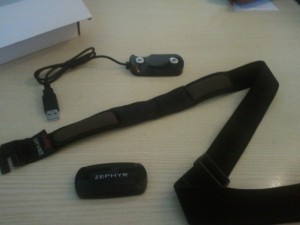I recently bought a Bluetooth cardio sensor, the Zephyr Hxm. Its selling points for me were the ability to use it together with my Android smartphone and the fact that Zephyr encourages developers to access its functionality through an open SDK.
The package contains:
- The sensor, which is very light but feels sturdy. On the rear end it has two male snaps to pop it in place and three connectors that are used by the charging cradle.
- A USB cradle to charge it, which has two female snaps and three pins that must be aligned with the connectors on the sensor.
- A strap that has two pads of “smart fabric” (the brown pads on the strap) that have to be both in contact with the skin of the chest when working out, in order to measure the heart pulse. On the other side of the strap there are two female snaps.
I connected the sensor to the cradle to charge it. There’s a red light that turns on when charging and then turns off when the sensor is at 100% battery; it took about an hour to charge it completely from unboxing state. Then I put a small amount of water on the brown pads of the strap,to make it connect better with the skin. I attached the sensor to the strap and I put it on. When the sensor feels a pulse, it turns on and the Bluetooth communication can be established. So I paired the sensor to my Android smartphone using 1234 as for the manual, and then started the “Zephyr Heart Monitor” app. It immediately connected to the sensor and started showing my pulse.
Other apps that integrate the information of this sensor are SportsTrackLive and My Tracks. I tried My Tracks, which is open source and in my opinion needs to be a little bit polished on the user interface side, that records your physical activity using the GPS and optionally the Zephyr heart sensor, and then can export the tracks to log files or to Google Docs.
Zephyr Technology also takes care of an open source project called zephyropen, that shows to developers how to connect and use their sensors. With the information and source code present in the project any developer can make its custom application, for smartphones or even for desktop environments, that uses the sensor data (mainly hearth rate and running cadence).


 Posts
Posts
Dani
2011/06/21
There is an app in Android called “Instant Heart Rate” which measures the heart rate using the camera (through small changes in the color of your finger). Would you try it and compare?
Balau
2011/06/23
“Instant Heart Rate” is a nice tool to get one measure of your heart rate anywhere you are.
On my Samsung Galaxy S it does not seem very reliable (jumps from ~70 to >180 easily), maybe because the camera doesn’t have a flash to illuminate the finger.
It can’t be expected to be used while doing sports, because having your finger always on the camera lens is not at all comfortable nor practical.
It could be used for daily monitoring of the heart rate at given times, for example when you wake up or after you come home.
Cardio-sensors like the Zephyr HxM are more useful when you need continuous non-intrusive monitoring for a long period of time.
prabhu
2011/06/29
hi , good blog and a good post.. i need an help from you, i am doing my part of thesis with the concept that i need to get the heart rate to my application and that a pplication needs to send a message to a prestored number as sms.
I planned to get zephyr device. can i use that device to show the data and use those data in my application to send a message..
Please do help me
Balau
2011/06/29
I think that if you want to do an Android application you should have all the tools available. A complete application should consist of:
Obviously you have to know Java.
An app like this can be done also for iPhone or other smartphones but I don’t know where to start.
Sakthi
2013/01/21
Hi , with the available software in the market, can you see *LIVE* hrv data on your android smartphone using this device?
Balau
2013/01/23
You mean the graph? No, I don’t know any app that does that.